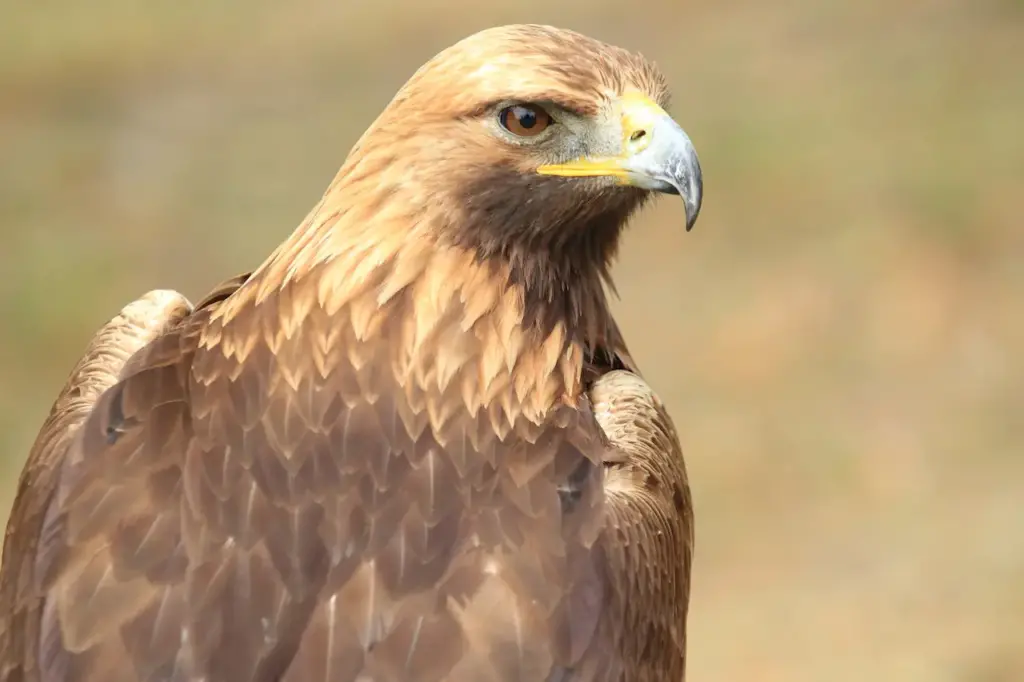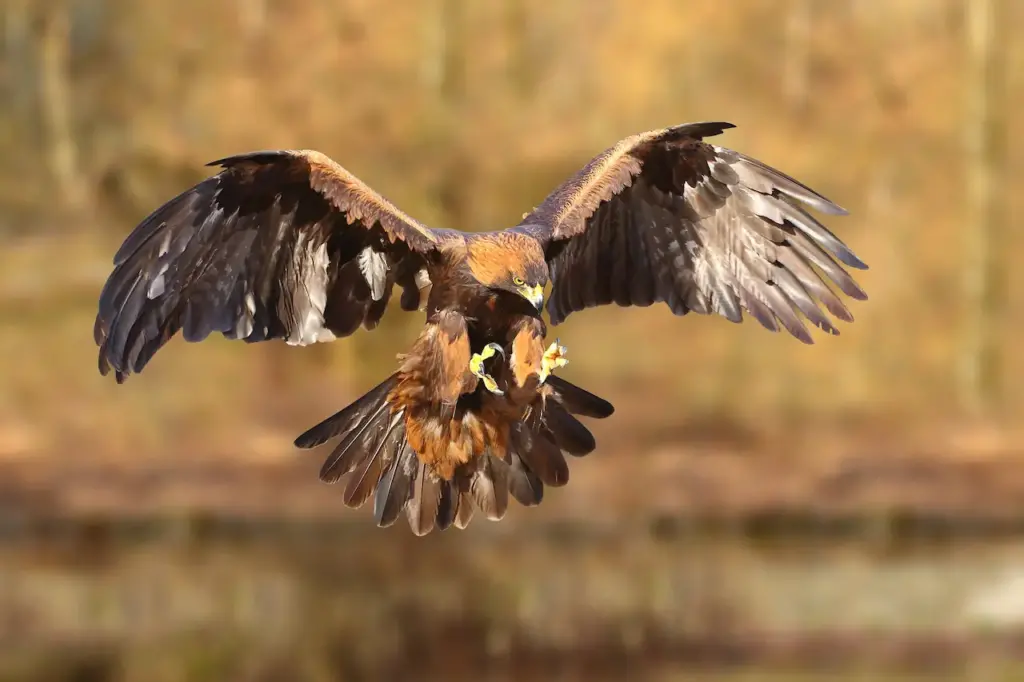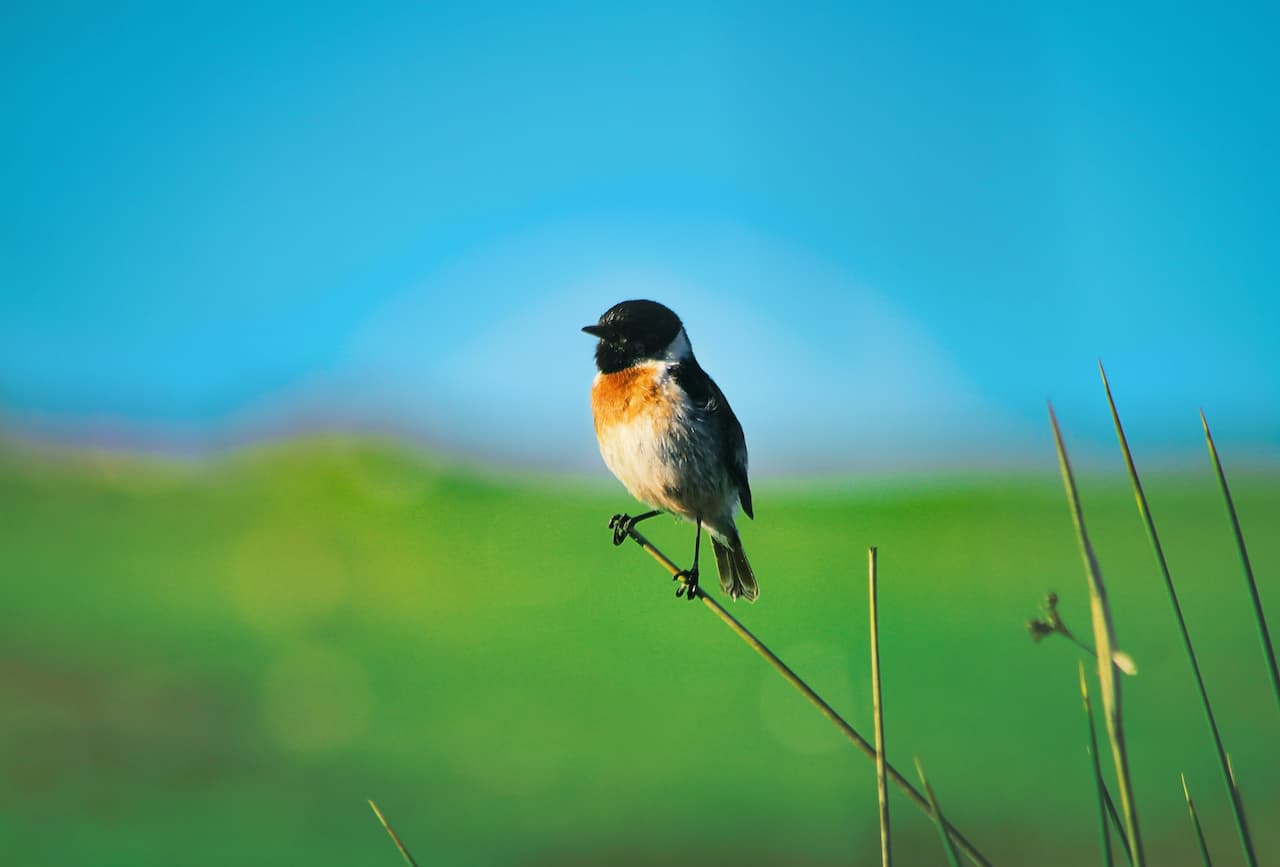Golden Eagles aka Royal Eagle, Aguila Reale, Kongeørn, Oakab
Golden Eagles aka Royal Eagle, Aguila Reale, Kongeørn, Oakab
The Golden Eagles (Aquila chrysaetos) is one of the best known birds of prey in the Northern Hemisphere. Like all eagles, it belongs to the family Accipitridae.
Once widespread across the Holarctic, it has disappeared from many of the more heavily populated areas. Despite being locally extinct or uncommon, the species is still fairly ubiquitous, being present in Eurasia, North America and parts of Africa.

These birds are dark brown, with lighter golden-brown plumage on their heads and necks. It has a wingspan averaging over 2 m (7 ft) and up to 1 m (3 ft) in body length. They are extremely swift, and can dive upon their quarry at speeds of more than 150 miles (241 kilometers) per hour.
Golden eagles use their speed and sharp talons to snatch up rabbits, marmots, and ground squirrels. They also eat carrion, reptiles, birds, fish, and smaller fare such as large insects. They have even been known to attack full-grown deer.
Golden eagle pairs maintain territories that may be as large as 60 square miles (155 square kilometers).
They are monogamous and may remain with their mate for several years or possibly for life. Golden eagles nest in high places including cliffs, trees, or human structures such as telephone poles.
They build huge nests to which they may return for several breeding years.
Females lay from one to four eggs, and both parents incubate them for 40 to 45 days. Typically, one or two young survive to fledge in about three months.
Description
Adult Golden Eagles range considerably in size, though some are among the largest eagles of the genus Aquila. Most subspecies of Golden Eagle vary in the range from 65 to 100 cm (26€“40 in) in length, wingspan can range from 150 to 240 cm (60€“96 in), and weight is from 2.5 to 7 kg (5.5€“15.5 lb).
The smallest-bodied subspecies is A. c. japonica while A. c. daphanea is the largest on average. However, wild specimens from Northwestern North America (A. c. canadensis) can exceed normal dimensions, as the largest recorded weighed 9 kg (20 lbs) and had a body length of 102 cm (40.1 in).
As with many Accipitriformes, females are considerably larger than males, in the case of the Golden Eagle they weigh one-quarter to one-third more than male birds.
The plumage colours range from black-brown to dark brown, with a striking golden-buff crown and nape, which give the bird its name. The upper wings also have an irregular lighter area.
Immature birds resemble adults, but have a duller more mottled appearance.
Also they have a white-banded tail and a white patch at the carpal joint, that gradually disappear with every moult until full adult plumage is reached in the fifth year. Contour feathers may be moulted in a short time span.
Subspecies and distribution
The type species is
- Aquila chrysaetos (Linnaeus, 1758) €“ Eurasia except Iberian peninsula, east to western Siberia.
Besides, there are five living subspecies of Golden Eagle that differ slightly in size and plumage. They can be found in different parts of the world:
- Aquila chrysaetos canadensis (Linnaeus, 1758) €“ North America.
- Aquila chrysaetos kamtschatica Severtzov, 1888 €“ Eastern Siberia, from the Altay to the Kamchatka Peninsula. Often included in A. c. canadensis.
- Aquila chrysaetos daphanea Severtzov, 1888 €“ Southern Kazakhstan east to Manchuria and south-west China, also northern India and Pakistan.
- Aquila chrysaetos homeryi Severtzov, 1888 €“ Iberian peninsula and North Africa, east to Turkey and Iran.
- Aquila chrysaetos japonica Severtzov, 1888 €“ Japan and Korea.
The larger Middle Pleistocene Golden Eagles of France (and possibly elsewhere) are referred to a paleosubspecies Aquila chrysaetos bonifacti, and the huge specimens of the Late Pleistocene of Liko Cave (Crete) have been named Aquila chrysaetos simurgh.
Feeding
Golden eagle predominant prey is leporids (hares and rabbits) and sciurids (ground squirrels, prairie dogs and marmots), the two groups normally comprising 50-94% of the diet of nesting eagles. Additional mammals regularly taken include mice, martens, foxes, young deer.
The secondary important prey group for eagles are other birds. Various gallinaceous birds (largely phasianids, ptarmigans and grouse) are the most significant avian prey.
However, virtually any bird, from a jay to a swan, is potential prey.
During winter months when prey is scarce, Golden Eagles scavenge on carrion to supplement their diet. Sometimes when no carrion is available golden eagles will hunt down large prey, such as goat-antelopes and caribou.
Reports have been made of mature adults killing wolves and other medium sized canine species.
There is one confirmed report of a Golden Eagle snatching the cub of a Brown Bear, and several other unverified attacks.
Golden eagles are avian apex predators, meaning a healthy adult is not preyed upon.
There are records of golden eagles killing and eating large raptors such as Eurasian Eagle Owls, Gyrfalcons, Goshawks and Buteo hawks, whether adults, nestlings or eggs.
In Zion National Park, an adult eagle passing by a Peregrine Falcon nest was struck and killed by a swooping parent Peregrine.
Falcons, jaegers and Buteos like Rough-legged Hawks, which are normally competitors, have worked together to group-mob Golden Eagles that have passed their adjacent nesting areas.
More commonly, Golden Eagles kleptoparasitize, or steal prey, from other raptors. Despite being often smaller in size, they are capable of displacing large vultures, of both unrelated families, from carrion.
However, the Bald Eagle and White-tailed Eagle can displace Golden Eagles in competition over food and vice versa.
Golden Eagles have very good eyesight and can spot prey from a long distance. The Golden Eagle has a resolving power 8x more powerful than a human.
The talons are used for killing and carrying the prey, the beak is used only for eating. They often have a division of labor while hunting, one bird driving the prey towards its waiting partner.
On the other hand, the size difference between males and females allows more unpaired birds to live off the land, which is helpful to maintain a sufficiently large population for this large and slowly-maturing bird.
Reproduction
Golden Eagles usually mate for life. They build several eyries (bird nests) within their territory and use them alternately for several years. These nests consist of heavy tree branches, upholstered with grass when in use.
Old eyries may be 2 metres (6.6 ft) in diameter and 1 metre (3.3 ft) in height, as the eagles repair their nests whenever necessary and enlarge them during each use. If the eyrie is situated on a tree, supporting tree branches may break because of the weight of the nest.
Certain other animals €“ birds and mammals too small to be of interest to the huge raptor €“ often use the nest as shelter. Their predators are just the right size for Golden eagle prey, and therefore avoid active eyries.
The female lays one to four (usually two) eggs between January and September (depending on the locality). The eggs vary from all white to white with cinnamon or brown spots and blotches.
They start incubation immediately after the first egg is laid, and after 40 to 45 days the young hatch. They are covered in fluffy white down and are fed for fifty days before they are able to make their first flight attempts and eat on their own. In most cases only the older chick survives, while the younger one dies without leaving the eyrie.
This is due to the older chick having a few days’ advantage in growth and consequently winning most squabbles for food.
This strategy is useful for the species because it makes the parents’ workload manageable even when food is scarce, while providing a reserve chick in case the first-born dies soon after hatching.
Golden eagles invest much time and effort in bringing up their young; once able to hunt on their own, most golden eagles survive many years, but mortality even among first-born nestlings is much higher, in particular in the first weeks after hatching
Congregation and Migration
As with many raptors, golden eagles congregate once a year. In Eurasia and North America, this congregation usually occurs in the Autumn (while congregations of bald eagles is a late-winter / early-spring phenomenon).
The largest known congregation, in number of birds present, of the golden eagle is in the state of Montana in October. The congregation site is the east slope of the Bridger Mountains and adjacent Bridger Canyon.
The mountain range is on the edge of the Rocky Mountain chain, where it borders parts of the Great Plains and several island ranges. Golden eagles from all over North America congregate here before migrating for the winter.
Status and conservation
At one time, the Golden Eagle lived in temperate Europe, North Asia, North America, North Africa and Japan. In most areas this bird is now a mountain-dweller, but in former centuries it also bred in the plains and the forests. In recent years it has started to breed in lowland areas again e.g. in Sweden and Denmark.
There was a great decline in Central Europe where they are now essentially restricted to the Apennine, Alps and Carpathian Mountains.
In Britain, there were about 420 pairs in 2007, the majority of these in the Scottish highlands, and between 1969 and 2004 they bred in the Lake District, Cumbria.
Golden Eagles can still often be seen soaring above mountains in Scotland, and are slowly returning to Northern England.

In Ireland, where it had been extinct due to hunting since 1912, efforts are being made to re-introduce the species. Forty-six birds were released into the wild in Glenveagh National Park, County Donegal, from 2001 to 2006, with at least three known female fatalities since then.
It is intended to release a total of sixty birds, to ensure a viable population.
In April 2007, a pair of Golden Eagles produced the first chick to be hatched in the Republic of Ireland in nearly a century. The previous attempt to help the birds breed at the Glenveagh National Park had failed.
In North America the situation is not as dramatic, but there has still been a noticeable decline. The main threat is habitat destruction which by the late 19th century already had driven Golden Eagles from some regions they used to inhabit.
In the 20th century, organochloride and heavy metal poisonings were also commonplace, but these have declined thanks to tighter regulations on pollution.
Within the United States, the Golden Eagle is legally protected by the Bald and Golden Eagle Protection Act.
Available habitat and food are the main limiting factor nowadays. Collisions with power lines have become an increasingly significant cause of mortality since the early 20th century.
On a global scale, the Golden Eagle is not considered threatened by the IUCN mainly thanks to the large Asian and American populations.
Falconry
Golden Eagles can be trained for falconry. In Kazakhstan, Kyrgyzstan, western Mongolia and China, Golden Eagles are still used to hunt foxes and Wolves by Kazakh and Kyrgyz nomads; the bird is locally known as burkut or berkut.
Foxes are killed outright by the eagles, but due to their size and strength wolves are usually held down while the falconer himself finishes the kill.
Heraldry
The Golden Eagle is the national bird of four nations, Germany and Austria in continuation of the Holy Roman Empire, and Mexico and Kazakhstan, the most of any species.
The eagle is very much connected to the Saladin Golden Eagle, currently used as the coat of arms of Egypt, Iraq, and Palestine, it was also previously used by Libya, and Yemen.
The Golden Eagle was model for the aquila, the standard of the Roman legions. It is featured in the national coats of arms of Germany, Austria, Egypt, Mexico, Romania and many other countries.
Religion
The eagle is a sacred bird in some cultures and the feathers of the eagle are central to many religious and spiritual customs, especially amongst some Native Americans in the United States and First Nations in Canada, as well as among many of the peoples of Meso-America.
Some Native American peoples revere eagles as sacred and the feathers and other parts of Bald and Golden Eagles.
Feathers are often worn on Native American headdresses and have been compared to the Bible and crucifix of Christianity.
Eagle feathers are often used in various Native ceremonies and are used to honour noteworthy achievements and qualities such as exceptional leadership and bravery.
Current United States eagle feather law (50 CFR 22) stipulates that only individuals of certifiable Native American ancestry enrolled in a federally recognized tribe are legally authorized to obtain eagle feathers for religious or spiritual use.
Thus, the supply of eagle material for traditional ceremonial use can be guaranteed and ceremonial eagle items can be passed on as heirlooms by their traditional owners without the restrictions that would usually apply.
Commercial trade in Golden Eagles or their feathers or body parts is not legalized by these exceptions.
On February 1, 2006 the Director Dale Hall of the USFWS issued a new permit to the Hopi Tribe for 2006. On April 26, 2007 USFWS Deputy Director Kenneth Stansell issued a new permit for 2007. As in the past, the permits authorize the Hopi to take up to 40 golden eaglets.
In keeping with a departure begun in 2003, the USFWS HQ in Washington, D.C., not the Regional Director in Albuquerque, New Mexico, issued the 2006 and 2007 Eagle permits.
The Regional Office issued a separate, new permit on March 23, 2007 for the Hopi to take an unlimited number of red-tail hawk nestlings in northeastern Arizona in 2007.
A new aspect of Native American religious eagle gathering is that additional tribes are now taking live eagles under USFWS permits, for the first time. They are:

Jemez Pueblo – In October 2006, the USFWS issued a permit to Jemez Pueblo to capture up to 2 golden eagles in the Valles Caldera National Preserve, administered by the Forest Service, in Sandoval County, New Mexico.
The USFWS had previously denied a Jemez request in 2002 to take eagles. In July 2007 Jemez reported that they successfully collected two immature golden eagles.
Taos Pueblo – In February 2007 the USFWS issued a permit to Taos Pueblo to shoot one mature golden eagle on Taos Pueblo Tribal lands in Taos County, New Mexico.
An additional permit allows the permittee to transport the taken eagle and its parts anywhere within the United States. Report was due to USFWS by December 31, 2007.
Isleta Pueblo – In April 2007, the USFWS issued a permit to the Pueblo of Isleta to take two mature golden eagles on Pueblo lands in Valencia and Bernalillo County, New Mexico. The Isleta Report is due on March 31, 2008.
Taxonomy and systematics
This species was first described by Linnaeus in his 1758 Systema naturae as Falco chrysaetos. The type locality is given simply as “Europa”; it was later fixed to Sweden.
The Golden Eagle is one of the large eagles in the genus Aquila, which are distributed almost worldwide. The latest research indicates it forms a worldwide superspecies with Verreaux’s Eagle, Gurney’s Eagle and the Wedge-tailed Eagle.




